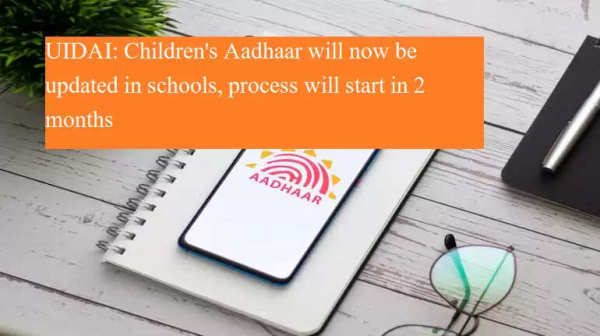
In a significant move to streamline Aadhaar services for children, the Unique Identification Authority of India (UIDAI) is preparing to initiate biometric updates directly in schools across the country. This new approach will target children aged five years and above, ensuring timely Aadhaar updates and smoother access to government services.
According to UIDAI, the process is expected to begin in a phased manner within the next two months. This initiative aims to address the biometric update backlog for nearly 7 crore children across India who have turned five but haven’t yet updated their Aadhaar data, as mandated.
As per UIDAI guidelines, children receive their Aadhaar card without biometric data if they are below five years of age. However, once a child turns five, a biometric update—consisting of fingerprints and iris scans—is mandatory. A second mandatory update is required at the age of 15.
Failing to update Aadhaar after turning seven can result in deactivation of the card. Children aged between 5 and 7 years can have their biometrics updated free of charge. However, if the update is not done on time and the child is above 7, a fee of ₹100 is charged for the process.
Biometric updates are essential for children to access various government schemes and services including school admissions, scholarships, entrance examinations, and health-related programs. By integrating the update process with schools, UIDAI aims to make Aadhaar services more accessible and efficient.
The UIDAI has already started coordinating with schools and local authorities to roll out this initiative. The organization will deploy biometric machines at the district level, which will then be circulated from one school to another. This mobile setup is designed to reach the maximum number of students in the shortest time.
In addition, UIDAI will obtain parental consent before updating any biometric data. Technical checks are underway to ensure data safety and accuracy during the school-based enrollment drives. The rollout is likely to begin within 45 to 60 days from now.
Looking ahead, UIDAI plans to utilize the same school and college networks to complete the second biometric update when a child turns 15. This strategy is expected to reduce the burden on Aadhaar centers and make the process more child-friendly.
Currently, schools are being identified, and UIDAI is in the process of training personnel to operate the biometric devices. Once operational, this initiative is expected to significantly reduce Aadhaar update delays and increase efficiency.
Aadhaar has become an essential document for accessing a wide range of government welfare schemes, especially those related to education and health. Ensuring timely updates helps children continue to benefit without interruptions or verification issues. From midday meals to educational grants, many schemes require a valid and updated Aadhaar number.
UIDAI's school-based approach could serve as a model for other large-scale data verification drives in the future, especially in remote and under-resourced areas where access to enrollment centers remains a challenge.
With the Aadhaar biometric update process becoming more accessible through schools, parents are advised to stay informed and cooperate with their respective school administrations. This proactive approach not only secures continued access to key services for children but also strengthens the national identity infrastructure.